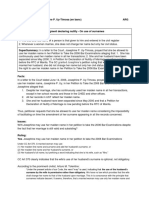LAB MANUAL OF
DATA VISUALISATION THROUGH
TABLEAU AND POWER BI
(MANC 0014)
“MASTERS OF BUSINESS ADMINISTRATION’’
(BUSINESS ANALYTICS)
Trimester-II
Batch 2024-26
Session 2024-25
Submitted By: Submitted To:
Pratibha Tiwari Mr. Mohit Payasi
Roll No: -2485100014
Student of MBA (BA)
POWER BI
Power BI is a Data Visualization and Business Intelligence tool by Microsoft that
converts data from different data sources to create various business intelligence
reports. Microsoft Power BI makes it easy for businesses to spot trends, track
performance, and make data-driven decisions.
This Power BI tutorial is your one-stop guide for learning Power BI from Scratch.
It covers all the basic and advanced concepts of Power BI like, filter Power BI,
Power BI desktop, functions in Power BI, Power BI services, etc.
What is Power BI
Power BI is the collection of software apps, services, and connectors that turn the
raw data into meaningful, immersive, and interactive insights.
It was developed by Microsoft and is very versatile to use. It can accept input
from Excel sheets, databases, or even cloud storage. You can connect the data
sources, derive insights, and share them with others. Power BI is the most popular
business intelligence tool out there, but why? let’s discuss why is Power BI in
demand and what makes it different from other tools.
Why Power BI?
In today’s world, “data is the new oil”. Organizations need a tool that can help
them understand the large amount of data that they are collecting. Microsoft Power
BI was introduced to fulfill their needs, It is a powerful data visualization and
analysis tool that allows businesses to turn raw data into actionable insights and
reports.
Power BI helps users who are beginners who do not come from an analytical
or tech background. Still, they can create reports on the Power BI desktop.
Features of Power BI
Some most important Power BI features are given below :
Data Visualization: Power BI is used by organizations to create interactive
reports and dashboards that visualize data in various ways, including charts,
graphs, and maps.
Collaboration: Power BI allows multiple users to work on the same report
or dashboard at the same time. This makes it easy for teams to collaborate,
share data and share insights.
Data Transformation: Power BI can transform raw data into useful
information that is a more usable format by cleaning and manipulating data.
This allows businesses to work with clean, accurate data that is easy to
analyze.
Integration: Power BI integrates with a wide range of other Microsoft
products or applications like Excel, SharePoint, and Teams. It helps in the
workflow of the projects.
APIs for integration. This feature provides developers with sample code
and APIs for embedding the Power BI dashboard in other software products.
Applications of Power BI
Microsoft Power BI is a powerful business intelligence tool that allows users to
analyze data and share insights in the form of graphical representations. Some
common practical applications of Power BI are:
1. Data Visualization
2. Data Management
3. Data Analytics With Internal Software Systems
4. Business Reporting
5. Provide complex data within software and apps
6. Streamline Organizational Processes
7. Data Collaboration and Sharing
8. Enhance the marketing
9. Real-time look at the company’s financial performance with financial
Dashboards
10. Create Consistent Reporting Standards
PROJECT 1
Q1 Runtime from series title
Q2 Released year by certificate
Q3 Imbd rating
Q4 Help in finding number of votes and sum of meta
score
Certification Distribution (Pie Chart)
Visualization: Pie Chart of Certification Categories
U (25.47%) and A (24.38%) dominate, indicating a mix of family-friendly
and mature content.
UA (20.01%) suggests many movies target both general and mature
audiences.
R-rated movies (18.43%) hold a significant share, likely due to adult-
oriented content.
Insight:
The dominance of U and A categories suggests the film industry produces
both general and mature audience films equally.
PG-13 and PG movies are less frequent, meaning family-oriented content
may not be as dominant in this dataset.
3. Gross Revenue by Genre (Bar Chart)
Visualization: Bar Chart comparing different genres' revenue
Action, Adventure, Sci-Fi leads with the highest gross (~6bn).
Animation, Adventure, and Drama genres also generate strong revenue
(~4-5bn).
Fantasy and Animated movies also contribute significantly.
Insight:
Action-Adventure films generate the highest revenue, likely due to their
appeal across global audiences.
Animation is a strong genre, showing family-friendly films have a steady
market presence.
Genres like Sci-Fi and Fantasy perform well, benefiting from franchise-
based films and high visual effects budgets.
4. IMDb Rating Distribution (Gauge Chart & Pie Chart)
Visualization:
Gauge Chart (Overall IMDb Rating Sum: 5.67K out of 11.33K)
Pie Chart (IMDb Ratings by Series Titles)
Insight:
The average IMDb rating is about 50% of the maximum, indicating a
mix of highly rated and average movies.
Vertigo, Warrior, and Wonder lead in ratings, showing their popularity
and critical appreciation.
The spread of ratings is relatively even, meaning different movie
franchises receive a balanced reception.
5. IMDb Ratings by Series Title (Pie Chart)
Visualization: Pie Chart showing the distribution of IMDb ratings among top
series
Highest-rated series include:
o Vertigo (14.87%)
o Warrior (14.73%)
o Wonder (14.68%)
o Trois Couleurs, Ying Xiong, Willy Wonka, and Vampire Hunter
Insight:
No single series dominates IMDb ratings, showing that audience
preferences are diversified.
A mix of classic and modern series receive top ratings, indicating
audience appreciation for both older and newer films.
6. Interactive Filters (Dropdowns)
Visualization: Dropdown Filters for Runtime, Director, and Series Title
Users can explore movie data based on:
o Runtime (Analyze short vs. long movies).
o Director (View performance of specific filmmakers).
o Series Title (Analyze franchise success).
Insight:
Filtering by Director can reveal which filmmakers produce top-grossing
or highly-rated movies.
Runtime analysis can show if shorter or longer movies perform better
financially.
Series-specific insights help compare different franchises.
Key Takeaways
Athletics is the most participated sport, followed by Swimming and
Rowing.
London has hosted the Olympics multiple times, along with Athens,
Beijing, and other cities.
Michael Phelps is the most decorated athlete, with the highest number of
Gold medals.
Gold, Silver, and Bronze medals are almost equally distributed.
Male athletes have won significantly more medals than female athletes
(65.71% vs. 34.29%).
PROJECT 2
Q1Count of winner in team1
Q2count of winner in team 2
Q3decision of toss winner
Q4count of target over by target run
Player Performance Analysis
Visualization: Bar Chart (Top Left) - "Count of Season by Player of the
Match"
The top-performing players based on the number of times they won the
Player of the Match award.
AB de Villiers and Chris Gayle lead, followed by Rohit Sharma, David
Warner, and Virat Kohli.
Other notable names include MS Dhoni, Ravindra Jadeja, Shane
Watson, and Andre Russell.
Insights:
AB de Villiers and Chris Gayle are among the most impactful players
across multiple seasons.
Strong presence of Indian players (Rohit Sharma, Virat Kohli, MS
Dhoni, and Jadeja) indicates their consistent match-winning
performances.
All-rounders like Jadeja and Russell also feature, highlighting their
value to their teams.
2. Target Runs vs. Target Overs Distribution
Visualization: Histogram (Top Center) - "Count of Target Overs by Target
Runs"
The distribution of target runs set in matches and the number of target
overs faced.
The peak range is between 120-180 target runs, with a slight spread
beyond 200.
Insights:
Most matches have a target in the range of 120-180 runs, which is
typical for T20 cricket.
Very few matches have targets exceeding 250 runs, indicating high-
scoring games are rare.
Matches with targets below 100 are uncommon, suggesting strong
batting performances in most games.
3. Team Performance Analysis
Visualization: Two Bar Charts (Bottom Left & Bottom Center) - "Count of
Winner by Team1 & Team2"
These charts show the number of matches won by different teams when
batting first (Team1) or chasing (Team2).
Teams like Mumbai Indians, Kolkata Knight Riders, and Chennai
Super Kings have the highest wins.
Insights:
Mumbai Indians are the most successful team overall, appearing at the
top in both batting first (Team1) and chasing (Team2) scenarios.
Kolkata Knight Riders and Chennai Super Kings also have strong win
records, proving their consistency.
Some teams have more success chasing than setting targets, which can
inform strategic decisions.
4. Toss Decision Trends
Visualization: Donut Chart (Bottom Right) - "Count of Toss Winner by Toss
Decision"
64.29% of toss-winning teams choose to field first, while only 35.7% opt
to bat first.
Insights:
Most teams prefer chasing over setting a target, indicating that knowing
the required score gives them an advantage.
Batting first is chosen less frequently, possibly due to pitch conditions or
pressure management in second innings.
5. Filtering Options (Top Right)
Season & Method Filters:
Users can filter by season to analyze trends over specific years.
Match decision methods (D/L or NA) are available, helping to assess
rain-affected games.
Final Key Takeaways
1. AB de Villiers, Chris Gayle, and Indian stars like Kohli and Sharma
dominate as Player of the Match winners.
2. Most matches have targets between 120-180 runs, with few exceeding
200.
3. Mumbai Indians, KKR, and CSK are among the most successful teams
in both batting first and chasing.
4. Chasing is the preferred strategy, as most teams choose to field first
after winning the toss.
5. The dashboard allows filtering by season and match method for more
in-depth analysis .
PROJECT 3
Q1count of medal by name
Q2count by city by season
Q3count of medal by season
Q4information of an athele by their name
Q5count of medal by year
1. Key Metrics Summary (Top Left)
136 - First recorded height of athletes.
100 - First recorded weight of athletes.
13 - First recorded age of athletes.
These values likely represent the minimum recorded values for these
attributes in the dataset.
2. Gender Distribution of Teams (Pie Chart - Left Center)
65.71% Male Athletes (M)
34.29% Female Athletes (F)
Insights:
Male athletes have historically dominated Olympic participation.
Female participation has increased but still lags behind male athletes.
3. Medal Distribution by Athlete (Bar Chart - Top Right)
Shows the top Olympic athletes based on the number of medals won.
Michael Phelps leads, with a significant number of gold medals.
Other notable athletes include Larisa Latynina, Nikolay Andrianov, and
Birgit Fischer-Schmidt.
Insights:
Michael Phelps' dominance in Olympic history is evident with the most
gold medals.
Many athletes with high medal counts are from swimming, gymnastics, and
athletics.
A mix of male and female athletes suggests strong performances from both
genders.
4. Historical Medal Trends (Line Chart - Bottom Left)
Displays the count of Bronze, Silver, and Gold medals over time.
The number of medals awarded has significantly increased over the
years.
Insights:
Early Olympics (1896-1920s) had fewer medals due to fewer events and
participating countries.
Significant growth after 1950, likely due to the inclusion of more sports
and global participation.
The gap between medal counts has remained relatively stable, indicating
fair competition across medal categories.
5. Medal Distribution by Season (Bar Chart - Center Right)
Summer Olympics have significantly more medals than Winter Olympics.
Insights:
Summer Olympics have more events and athletes compared to the Winter
Olympics.
Winter Olympics participation is geographically restricted to colder
regions, leading to fewer events and medals.
6. City-wise Medal Distribution by Season (Pie Chart - Bottom Right)
83.96% of medals are from Summer Olympics cities.
16.04% are from Winter Olympics cities.
Insights:
Reinforces the dominance of the Summer Olympics in terms of event count
and participation.
The Winter Olympics, despite their smaller scale, still contribute a
significant portion of medals.
7. Filtering Options (Top Right)
Athlete Name Filter - Allows selection of individual athletes for medal
analysis.
Medal Type Filter - Users can focus on Bronze, Silver, or Gold medals.
Gender Selection (F/M) - Filters data to show male or female athlete
performance.
Final Key Takeaways
1. Male athletes historically dominate participation (65.71%).
2. Michael Phelps holds the most medals, highlighting swimming’s
prominence.
3. Medal counts have grown significantly over the years, reflecting the
expansion of the Olympics.
4. Summer Olympics contribute the majority of medals (83.96%).
5. Filters allow deep dives into athlete-specific and season-specific
performance.
TABLEAU
Tableau is a powerful tool used for data analysis and visualization. It allows the
creation of amazing and interactive visualization and that too without coding.
Tableau is very famous as it can take in data and produce the required data
visualization output in a very short time. Basically, it can elevate your data into
insights that can be used to drive your action in the future.
What is Tableau?
Tableau is a visual analytics platform that is revolutionizing the way we use data to
solve problems by enabling individuals and organisations to make the most of their
data.
Tableau is a great data visualization and business intelligence application that can
be used to report and analyse massive amounts of data. Salesforce purchased
Tableau in June 2019, an American firm founded in 2003. It enables users to build
various charts, graphs, maps, dashboards, and stories for visualising and analysing
data in order to aid in business choices. Tableau offers several unique and
fascinating features that make it one of the most popular business intelligence (BI)
applications.
Why use Tableau?
Tableau is the fastest and most powerful visualization tool. It is very easy to use.
There are no complex formulas like Excel and other visualization tools. It provides
the features like cleaning, organizing, and visualizing data, it easier to create
interactive visual analytics in the form of dashboards. These dashboards make it
easier for non-technical analysts and end-users to convert data into understandable
ones.
Tableau Features
Tableau supports powerful data discovery and exploration that enables users
to answer important questions in seconds
No prior programming knowledge is needed; users without relevant
experience can start immediately with creating visualizations using Tableau
It can connect to several data sources that other BI tools do not support.
Tableau enables users to create reports by joining and blending different
datasets
Tableau Server supports a centralized location to manage all published data
sources within an organization
Values in Tableau
There are two types of values in the tableau:
Dimensions: Values that are discrete(which can not change with respect to
time) in nature called Dimension in tableau. Example: city name, product
name, country name.
Measures: Values that are continuous(which can change with respect to
time) in nature called Measure in tableau. Example: profit, sales, discount,
population.
Advantages of Tableau
Quick calculation- All the calculations on the tableau done by the backend,
so it is relatively faster than any other tool.
Interactive dashboards– Tableau dashboards are very interactive and easy
to draw.
No manual calculation- All the calculations are done by the tableau only.
There is no manual calculation, but in some specific cases, we used
calculated fields for calculation.
A large amount of data- Tableau can handle a large amount of data.
Different types of visualization can be created with a large amount of data
without impacting the performance of the dashboards.
Disadvantages of Tableau
High Cost- tableau is a paid tool for visualization, and it is a reason why
people are not using tableau so much.
Static and single value parameters- Tableau’s parameters are static and
always single value can be selected using a parameter. Whenever the data
gets changed, these parameters need to be updated manually every time.
Limited Data Preprocessing- Tableau is strictly a visualization tool.
Tableau Desktop allows you to do very basic preprocessing
PROJECT
1. Sheet 1: Profit Distribution by Category and Customer
Visualization Type: Bar Chart
Description: This chart displays the profit distribution across different
categories, sub-categories, and customer names. The categories represented
are Clothing, Electronics, and Furniture.
X-Axis: Customer names are categorized by Clothing, Electronics, and
Furniture.
Y-Axis: Profit, ranging from -0.5K to 0.5K.
Colour Coding:
o Clothing: Red
o Electronics: Blue
o Furniture: Green
Purpose: To show how each customer contributes to the profit or loss in
each category and sub-category.
Insights: Identifies which customers and categories are generating the most
profit or incurring the most loss.
2. Sheet 2: Sub-Category Distribution within a Category
Visualization Type: Pie Chart
Description: This pie chart shows the distribution of sub-categories within a
selected category.
Labels: The sub-categories labelled are "Accessor.." and "Bookcases."
Legend: Lists the states: Bihar, Delhi, Gujarat, Kerala, Madhya Pradesh,
Maharashtra, Punjab, Rajasthan, Uttar Pradesh, and West Bengal.
Purpose: To visualize the proportion of sub-categories within the selected
category.
Insights: Helps understand which sub-categories are most prominent within
the chosen category across different states.
3. Sheet 3: Category and Payment Mode Analysis
Visualization Type: Bubble Chart and Bar Chart
First Visualization: Bubble Chart
o Description: Displays the distribution of categories across different
states.
o Colour Coding:
Clothing: Red
Electronics: Blue
Furniture: Orange
o Bubble Size: Represents the magnitude or frequency of the category in
each state.
o Purpose: To show the distribution and prominence of different
categories across various states.
o Insights: Reveals which categories are more dominant in specific
states.
Second Visualization: Bar Chart
o Description: Shows the amount spent using different payment modes.
o X-Axis: Payment modes: COD, Credit Card, Debit Card, EMI, and
UPI.
o Y-Axis: Amount, ranging from 0K to 150K.
o Purpose: To visualize the payment mode preferences of customers.
o Insights: Indicates the popularity of different payment methods, with
COD having the highest amount and Debit Card having the lowest.
Overall Purpose
This dashboard provides a detailed overview of profit distribution, sub-category
distribution, and payment mode preferences across different states and categories.
It offers valuable insights into customer behaviour, sales performance, and
payment trends, making it a powerful tool for data analysts and business
professionals to make informed decisions.
Q1 Which customer category (Clothing, Electronics, or Furniture)
contributes the most to the overall profit or loss, and how do individual
customers within that category perform?
Q2 How do different states compare in terms of the prominence of various
categories (Clothing, Electronics, Furniture) as shown in the bubble chart,
and what trends can be observed?
Q3 What insights can be gained from the payment mode preferences of
customers, and why might certain payment methods like COD have
significantly higher amounts compared to others like Debit Card?























































































